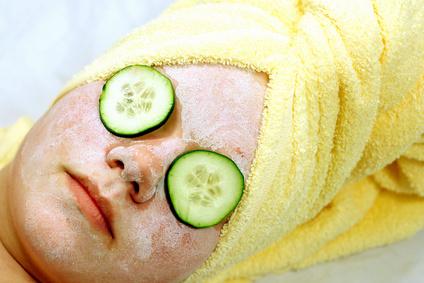Combination skin–oily in some parts, dry in others–may prove the most difficult to care for. The T-zone area, which includes the forehead, nose and chin, secretes too much oil. Your cheeks and around your eyes will often feel dryer. For the best results caring for your combination skin, use balancing products designed to treat the skin type.
Cleanser
You’ve probably fallen into the temptation to cleanse your face with only the oily parts in mind. This can actually increase the problems with combination skin. Avoid harsh soaps and acne-type facial cleansers. Make a simple liquid cleanser by pouring 4 cups boiling water over 4 oz. of grated, high-quality soap. Stir until the soap melts. For every 2 oz. of the soap mixture, add 1 tbsp. apple cider vinegar and 10 drops of essential oils, such as lemon and lavender.
Mask
A mask helps pull impurities from the skin. While you can use any clay mixed with water, it can dry your combination skin. A better choice is a simple gel mask. Cube a cucumber and puree it with a large aloe leaf. Spread the mixture all over your face and leave it on for approximately 30 minutes. Rinse off with cool water.
Toner
A balancing toner will soothe the irritated, dry patches while reducing the oily skin. Rosewater makes a good all-purpose toner. It soothes and tones the skin, according to aromatherapist Valerie Worwood in her book, “The Complete Book Of Essential Oils and Aromatherapy.” Make a simple at-home toner using fresh cucumber juice. If you have excessive oil, use an astringent, such as witch hazel, on those areas. Combine 3 parts floral water, such as orange flower water, to 1 part witch hazel. Add 1 tsp. apple cider vinegar for every 4 oz. The vinegar helps balance your skins pH. Wipe it onto the oily areas only.
Moisturizer
Finding the right moisturizer for combination skin is difficult. You want something that hydrates the skin, but ideally one that has no oil-based ingredients. Look for a broad-spectrum sunscreen to wear during the day. Check the Environmental Working Group’s “2010 Sunscreen Guide” for help deciphering the ingredients and choosing the safest products. For a nighttime cream, look for natural ingredients, such as vitamin A and vitamin C, in a water-based formula.
Photo Credit
- getting a facial image by Kelly Kane from Fotolia.com





